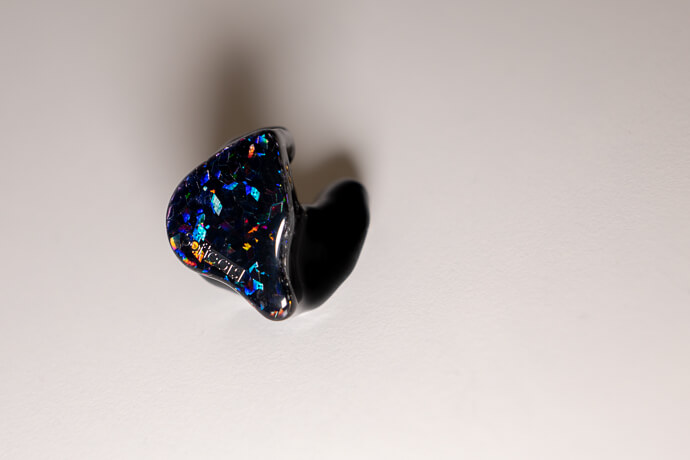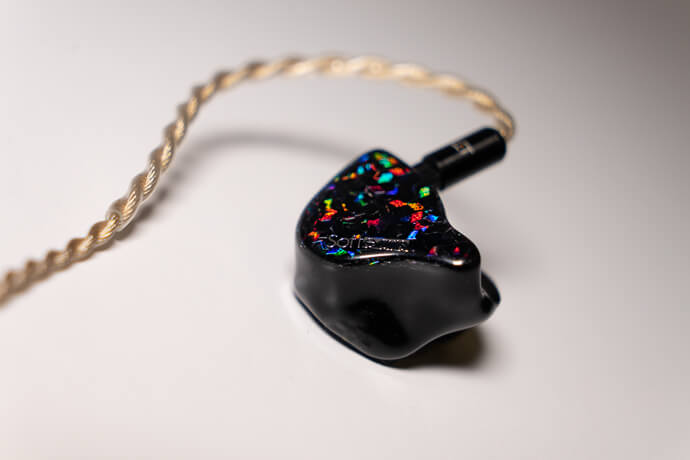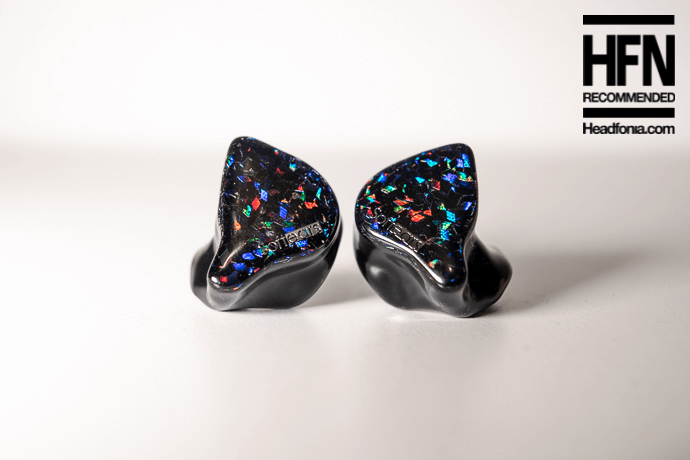Build Quality and Cable
Build quality is very good as well, as the earpieces are nicely made. The sound bores are cut nicely too, and they have a Vision Ears type of nozzle design. To minimize the earwax build-up, the nozzles have a recessed design. Nicely done. The faceplate closing is not perfect though, as I can see a few scratch marks and blemishes around the faceplate lines. They’re only visible from very close range, but this is not absolute perfection regardless. The 2-pin sockets are flush and the cables stick nicely.
The cable is the same stock cable as the universal RS10 and Cerberus models. The cable is a very important aspect of an IEM, for both sound and aesthetics, let alone with a high-end flagship model. And the cable Softears supplies is very underwhelming. I’m not going to say that the cable doesn’t have good wires or it’s low-quality since I don’t know the supplier at all. And it would’ve been understandable with a mid-range IEM, but not with a flagship, high-end, premium-priced IEM.
Even the RSV has a better cable, at least in terms of the quality feel and looks. The colour of this one is complementary to the RS10 maybe, but not to the Cerberus. And when I paired these Softears IEMs with good cables, I heard improved results in terms of overall presentation and technical performance. I see this issue from time to time with different manufacturers and they need to recognize the importance of a good quality cable.

Softears Cerberus
Fit
The fit of the Softears models is very good with the universal ones. But since this is a custom model, I think the experience is vastly improved. Softears has a very comfortable CIEM fit. The shells feel very good and comfortable in the ear and they also block lots of outside noise. The Cerberus has a vent for the dynamic driver so its isolation is a bit less in theory, but in reality, I didn’t have any problems regarding isolation.
When it comes to custom IEMs, there’s a balance between isolation and comfort. Softears leans on the comfort side of things, and I’m not complaining. Despite the busy configuration, the shells are not very huge either. Hence you have a very comfortable experience and I sometimes forget them in my ears.
Sound Quality
Note: This topic has similar sections with the universal review with additions and edits.
The Cerberus has a different approach to sound than many monitors in the market. It’s not a bass-heavy IEM at all, and yet, it’s not treble-focused either. It has dynamic drivers for bass and EST for treble, but the presentation has really caught me by surprise. Because I think the most impressive feat of the Cerberus is definitely in its mid-range.
Cerberus is my favourite Softears IEM for many reasons. One of the reasons is its unexpected coherency and balance despite being a tribrid IEM. Another reason for me is its great musicality and fantastic timbre. Although not being that much strong technically, I would prefer it over the RS10 myself.

Softears Cerberus
Perhaps that has something to do with my listening preferences. I listen to a lot of Jazz and I think Cerberus is one of the best high-end IEMs for Jazz listening, simply because of its incredible timbre quality, soft and smooth nature, and very controlled bass. Whilst the RS10 represents “neutrality and transparency”, the Cerberus represents “naturalness, and musicality” to me.
I often find myself reaching out for the Cerberus when I came home from work. The RS10 is my choice at the office. That should tell you something. The Cerberus is for relaxing, listening to some instrument timbre, the piano, the violin, the sax, the guitar.
Of course, one might wonder how the custom version compares to the universal. I will explain that very soon, but first, let me describe the sound of the Cerberus overall.

Softears Cerberus
Bass
As I mentioned, the Cerberus actually has less bass quantity than the RS10, which has been the biggest surprise for me ever since I received the universal. It has a dynamic driver but this driver is tuned incredibly well to be very balanced, controlled, and realistic overall.
Lows come from a wide area, and it feels like the bass overall has great space and layering with the Cerberus. The RS10’s bass is tighter a little bit, but it has more quantity and sometimes the midbass becomes just a bit overpowering for Jazz recordings. The Cerberus on the other hand feels much more natural with Jazz and Classical to my ears.
The bass quality you get with the Cerberus is extremely good. You’re not going to be impressed by the quantity at all, but the control and naturalness of the bass is something special. It’s even more impressive with the custom version.
The bass has great air with the Cerberus, so it feels a bit more natural in lows. I really like when companies tune these dynamic drivers this well. Usually, dynamic drivers give too much bass with an imbalanced bass presentation. That’s not the case with the Cerberus, as the bass is perfectly under control and it has just the right amount to be flexible, and it feels very very natural.
Page 1: Intro, Package and Design
Page 3: More About the Sound, Custom vs. Universal
Page 4: Comparisons and Conclusion







